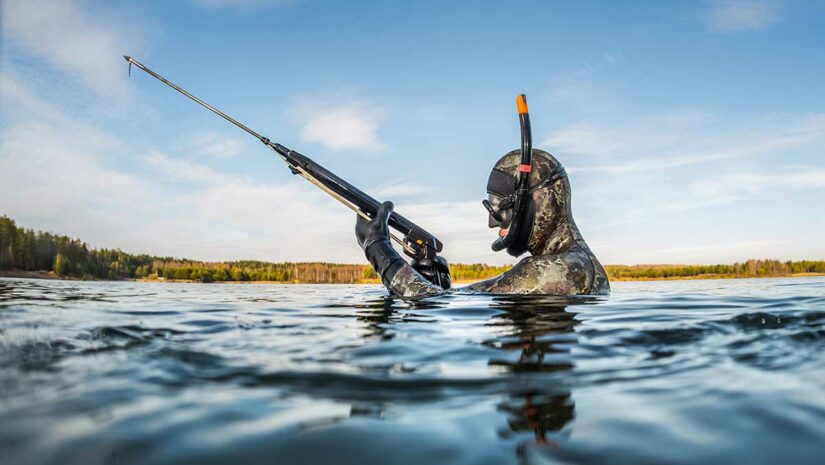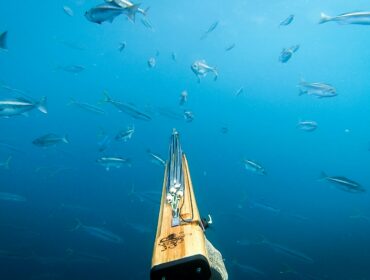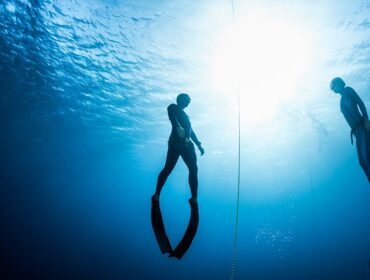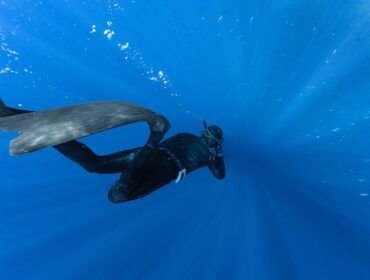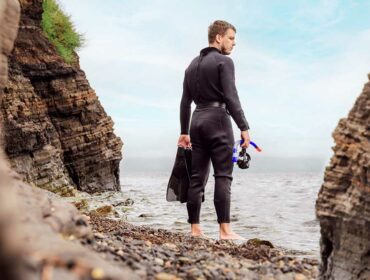Spearfishing is an exhilarating blend of hunting and diving, an ancient practice that has evolved into a modern sport and subsistence activity. At its core, spearfishing involves free-diving into the depths of the ocean or other water bodies, armed with a spear or speargun, to catch fish. But like any sport that intersects with the unpredictable nature of the wild, the right gear is paramount not only for success but also for safety.
Among the arsenal of equipment a spearfisher needs, the snorkel stands out. While it might seem like a simple tool, a well-chosen snorkel can make a significant difference in a spearfisher’s ability to navigate underwater, conserve energy, and approach prey stealthily. In this blog, we will dive deep into the world of spearfishing snorkels, exploring their importance and how to choose the right one.
What is a Spearfishing Snorkel?
A spearfishing snorkel is a specialized breathing device used by spearfishers to maintain a consistent airflow while swimming near the surface of the water. Its primary purpose is to allow the diver to breathe comfortably without lifting their head above water, enabling them to observe underwater environments and prey seamlessly.
When submerged, the snorkel helps the diver conserve oxygen in their lungs by preventing unnecessary surface trips. This extended observation time, combined with the element of stealth, enhances the diver’s chances of spotting and successfully catching fish.
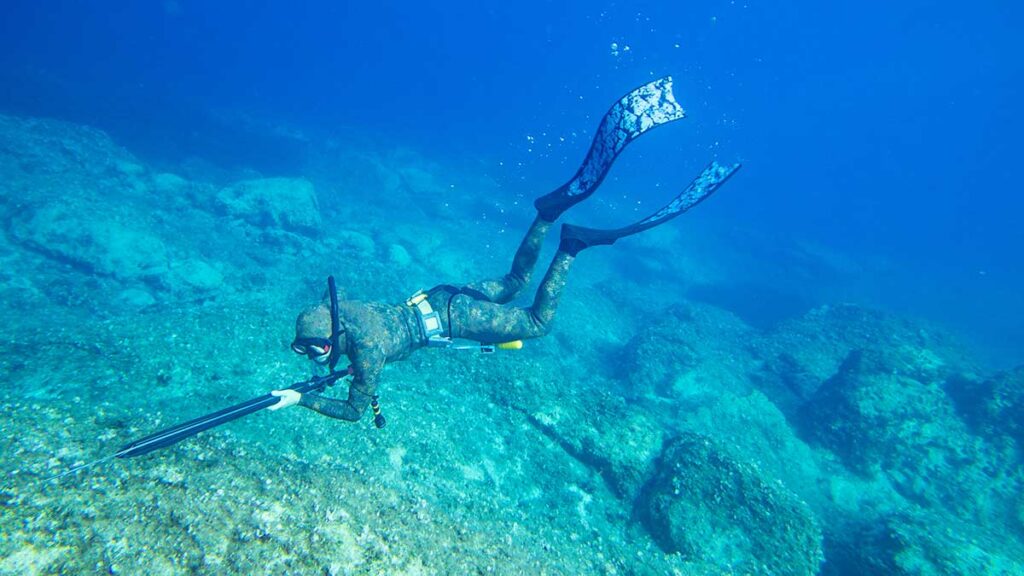
Differences between regular and spearfishing snorkels
At a cursory glance, spearfishing snorkels might seem similar to regular snorkels. However, there are distinctive differences tailored to the unique needs of spearfishers:
- Low Profile: These snorkels are typically designed to be streamlined and low profile, reducing drag while swimming. This design helps spearfishers move swiftly and stealthily.
- Color: Many spearfishing snorkels come in muted or camouflage colors. Unlike snorkeling for recreation, where bright colors might be preferred for easy spotting, spearfishing requires blending into the underwater environment to avoid alerting potential prey.
- Flexibility: While some recreational snorkels are rigid, spearfishing snorkels tend to be more flexible, allowing them to be moved out of the way when aiming or shooting a speargun.
- Mouthpiece: The mouthpiece in spearfishing snorkels is typically designed for extended use, ensuring comfort during longer dives and reducing jaw fatigue.
In essence, while all snorkels serve the primary function of aiding breathing near the water’s surface, spearfishing snorkels are specifically tailored to the demands of hunting underwater, prioritizing stealth, efficiency, and reliability.
Why is a Snorkel Important in Spearfishing?
While a snorkel might appear to be a simple piece of tubing, its implications as a spearfishing tool are profound. From conserving oxygen and providing a stealthy observation platform to ensuring minimal disturbance in the marine environment, a diving snorkel is undoubtedly an essential tool in your underwater gear.
Breath-Hold Diving and the Importance of Oxygen Efficiency
Spearfishing is predominantly conducted through breath-hold diving, also known as freediving. Unlike scuba diving, where divers have a consistent supply of oxygen from tanks, spearfishers rely solely on the oxygen stored in their lungs during a single deep breath before submerging.
This limitation means that every second underwater counts and conserving oxygen becomes crucial. A snorkel becomes an invaluable tool in this context. When a spearfisher is near the surface, scouting or preparing to dive, the snorkel allows them to breathe without regularly lifting their head for air. This conserves energy and keeps the heart rate steady, both of which are vital for optimizing the time and depth of the subsequent dive.
Scouting Prey Without Disturbing the Marine Life
The ocean is a vast expanse, and finding prey requires keen observation. A snorkel aids spearfishers by allowing them to float on the surface and breathe comfortably while keeping their eyes submerged and scouting for fish.
This prolonged and passive observation is less likely to disturb marine life compared to frequently emerging for air. It also provides the advantage of understanding the movement patterns and habits of potential prey, which can be crucial for a successful hunt.
Stealth and Minimal Water Disturbance
One of the primary tenets of spearfishing is stealth. Fish are incredibly sensitive to disturbances in the water, and any unnecessary movements can alert them to the presence of a predator.
Snorkels play a pivotal role in maintaining a spearfisher’s stealth quotient. By using a snorkel, the diver can remain mostly submerged, creating minimal water ripples and reducing direct exposure to fish that might be scared off by a human silhouette.
Furthermore, the act of lifting one’s head frequently to breathe can create noise and disturbance. A snorkel eliminates this need, ensuring the water remains as undisturbed as possible, which is especially crucial in the final moments before a strike.
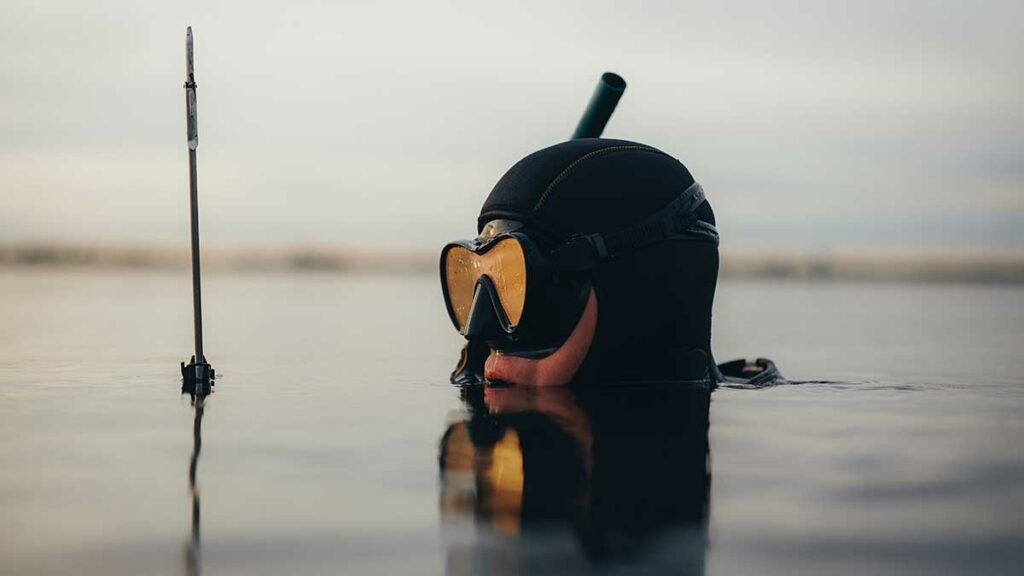
Types of Snorkels Suitable for Spearfishing
The choice of snorkel in spearfishing hinges on individual preferences and the specific conditions in which one dives. Whether prioritizing simplicity, adjustability, or a dry breathing experience, understanding the distinct features and nuances of each snorkel can significantly enhance your spearfishing adventures.
Simple J Snorkel
A Simple J snorkel is a basic and traditional type of snorkel, characterized by its straightforward, curved tube design. With no additional features or valves, it offers a direct airway from the surface to the diver’s mouth, prioritizing simplicity and ease of use.
Pros:
- Simplicity: As the name suggests, the Simple J Snorkel is basic in design, typically just a single curved tube. This simplicity translates to fewer parts that could potentially malfunction or break.
- Easy to Clear: Without any valves or chambers, clearing water from a J snorkel is straightforward and can be done quickly with a forceful exhale.
- Durability: With fewer moving parts and a simple design, J snorkels tend to be more durable and long-lasting.
Cons:
- No Water Prevention: The open design means water can easily enter the snorkel from splashes or waves, which might be inconvenient for some divers.
- No Flexibility: The rigid structure doesn’t offer any adjustability, which may not be ideal for all divers’ preferences.
Best Practices for Usage:
- When diving, it’s advisable to take a deep breath and then expel a small amount of air to create a bubble that can prevent water from entering the snorkel.
- If water does enter, a quick and forceful exhale once you surface will clear the snorkel efficiently.
Flex Snorkel
A flex snorkel for spearfishing features a flexible lower section, allowing divers to adjust the mouthpiece position for enhanced comfort. This design aids in reducing jaw fatigue and provides a more customizable fit during prolonged underwater hunts.
Pros:
- Adjustability: The main selling point of the Flex Snorkel is its flexible lower section, allowing divers to adjust the mouthpiece position for comfort.
- Comfort: The flexible section can reduce jaw fatigue as it can move slightly with the motion of the jaw.
Cons:
- Potential for Malfunction: The added complexity of a flexible section means there’s a slightly higher chance for issues or malfunctions over time.
- Water Trapping: The flex section can sometimes trap a small amount of water, requiring the diver to clear it more often.
Adjustability Features:
- Bendable Lower Section: The Flex Snorkel’s defining feature is its flexible lower portion, which can be bent or adjusted according to the diver’s preference.
Dry Snorkel
A dry snorkel for spearfishing is equipped with a float valve mechanism that seals off the snorkel’s top when submerged, preventing water entry. Additionally, many feature a splash guard to deflect surface water splashes. These designs ensure that spearos have a consistently dry breathing experience, especially beneficial in wavy or choppy conditions.
Features and How They Work:
- Float Valve: A unique feature of the Dry Snorkel is the float valve mechanism. When a diver submerges, the float rises due to the water pressure, sealing off the snorkel’s top and preventing water from entering.
- Splash Guard: Many dry snorkels have a splash guard at the top, which deflects water splashes from waves or surface turbulence, preventing them from entering the breathing tube.
Pros:
These are the benefits of dry snorkels for spearfishing
- Water Prevention: The combination of the float valve and splash guard ensures that water rarely enters the snorkel, providing a dry breathing experience.
- Automatic Sealing: The snorkel automatically seals off when submerged, eliminating the need for the diver to manually clear the snorkel upon resurfacing. This is a particularly useful snorkel feature for deep spearfishing dives; where surfacing may not always be smooth and you don’t want a mouthful of water upon ascent.
Cons:
- Complexity: The mechanisms in a dry snorkel can potentially malfunction or wear out over time.
- Breathing Resistance: Some divers feel that dry snorkels offer slightly more resistance to breathing, especially if the float valve doesn’t drop immediately upon surfacing.
When and Why to Use:
- Choppy Waters: Dry snorkels are particularly useful in choppy or wavy conditions where regular snorkels might constantly fill with water.
- Extended Surface Time: For divers who spend extended periods on the surface scouting for prey, the dry snorkel ensures a consistently dry breathing experience.
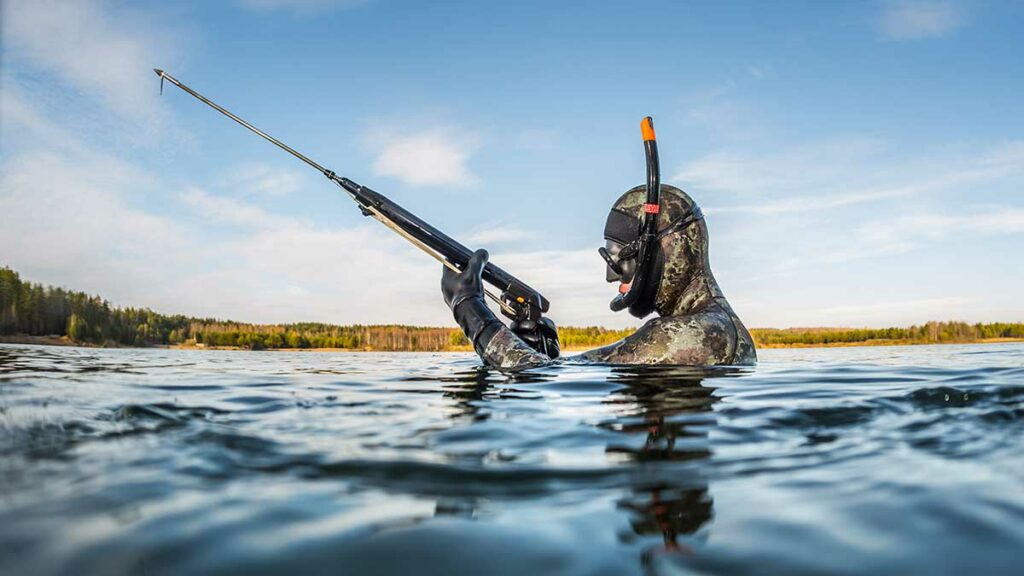
How to choose a spearfishing snorkel: Key Features
By considering the key features outlined below and combining that knowledge with diff. types of snorkels mentioned above; spearos can make a well-informed choice tailored to their unique requirements.
Material: Durability and Flexibility
- Durability: The material from which a snorkel is crafted plays a pivotal role in its longevity. Most spearfishing snorkels are made of high-quality silicone or rubber. Silicone is particularly favored due to its resistance to UV rays, which can degrade and weaken the material over time. Quality materials can withstand the constant exposure to saltwater, sun, and external pressures without cracking, tearing, or becoming brittle.
- Flexibility: While durability is essential, flexibility cannot be ignored, especially for those who opt for flex snorkels. A good spearfishing snorkel should strike a balance between being sturdy enough to maintain its shape and flexible enough to bend without snapping or kinking, which can restrict airflow.
Mouthpiece: Comfort and Fit
- Comfort: Given that spearfishers might be in the water for extended periods, a comfortable mouthpiece is crucial. The best mouthpieces are typically made of soft, hypoallergenic silicone that molds to the diver’s mouth contours without causing irritation or discomfort.
- Fit: A proper fit is vital to prevent jaw fatigue. Some snorkels come with replaceable mouthpieces, allowing divers to choose one that suits their mouth size and shape best. An ill-fitting mouthpiece can lead to discomfort and reduced focus during hunts.
Valve System: Purge Valves for Easy Clearing
- Purge Valves: Located at the base of the snorkel, purge valves provide an efficient method to clear out any water that might have entered. Instead of forcefully exhaling through the top of the snorkel, divers can simply breathe out normally, and the valve will let the water out while preventing new water from entering. This is especially handy for spearfishers, as it allows for quicker clearing and less disturbance in the water.
Snorkel Clip: Securing to the Mask
- Secure Attachment: The snorkel clip ensures that the snorkel remains securely attached to the mask strap. A reliable clip is essential to prevent the snorkel from coming loose during dynamic underwater movements or when brushing against underwater structures.
- Ease of Adjustment: While security is paramount, divers should also be able to easily adjust or detach their snorkel when needed. Clips that offer quick-release or easy-slide mechanisms can be particularly beneficial.
Size and Length: Optimal Breathability and Reduced Drag
- Optimal Breathability: The snorkel’s diameter should be sufficient to allow for comfortable breathing without feeling restricted. A snorkel that’s too narrow can hinder airflow, making breathing laborious, especially during prolonged surface intervals.
- Reduced Drag: The length of the snorkel is crucial for reducing drag underwater. A snorkel that’s too long will create unnecessary resistance, slowing the diver down. It should be long enough to allow surface breathing without frequent submersion but not so long that it becomes cumbersome.
Color: Camouflage vs. Bright Colors
- Camouflage: For spearfishers, blending into the underwater environment can be advantageous. Muted, camouflage colors can help divers approach their prey stealthily without alarming them.
- Bright Colors: While stealth is often a priority in spearfishing, there are situations, especially in busy waters, where visibility is essential for safety. In such cases, a brightly colored snorkel can help other water users spot the diver easily.
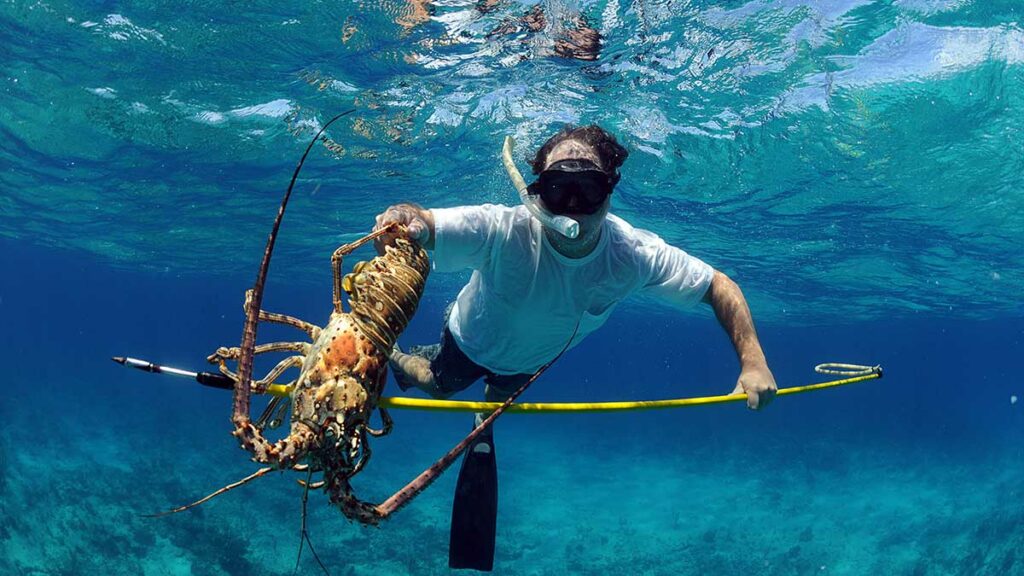
Spearfishing Snorkels Maintenance Tips
Spearfishing snorkels, like any other diving equipment, demand proper care to ensure longevity and optimal performance. Here’s a guide on how to maintain them:
Cleaning After Each Use
Saltwater and other aquatic elements can degrade your snorkel over time. After each dive, it’s essential to rinse the snorkel thoroughly with fresh water. This will help remove salt residues, microorganisms, and any other potential contaminants. For a deeper clean, occasionally soak it in a mixture of water and mild detergent, ensuring all soap is rinsed off afterward.
Storing Away from Direct Sunlight
UV rays can weaken and deteriorate the materials of your snorkel, especially if it’s made of silicone. Always store your snorkel in a cool, shaded place. Avoid leaving it out in the sun for extended periods, even if it’s just on the deck of a boat or the beach.
Periodic Inspections for Wear and Tear
Regularly inspect your snorkel for signs of wear, like cracks, tears, or compromised valve systems. Also, check the mouthpiece for signs of degradation. Catching these issues early can prevent more significant problems in the future and ensure your snorkel is always ready for your next spearfishing adventure.
By following these straightforward care tips, spearfishers can ensure their snorkel remains in top condition, ready for many more dives to come.
Conclusion
Spearfishing isn’t just about the chase and the catch; it’s about merging with the underwater world in the most seamless manner possible. An integral part of this experience is having the right snorkel. Just as a hunter requires the perfect bow or rifle, a spearfisher’s choice of snorkel can significantly influence their comfort, stealth, and overall success underwater.
Remember, in the vast expanse of the ocean, it’s not just the big equipment that matters, but also the seemingly small tools that can make all the difference. As with any sport or activity, investing in high-quality dive gear isn’t just about enhancing performance; it’s a commitment to your safety. By ensuring you have a reliable snorkel tailored to your needs, you pave the way for both efficiency and safety in your spearfishing adventures.

